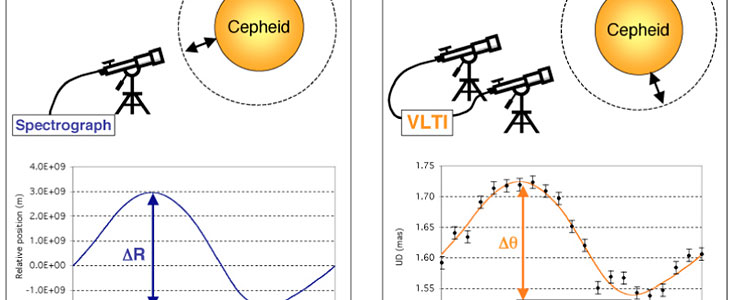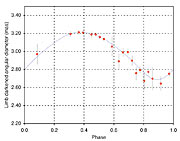Comunicato Stampa
Measuring Cosmic Distances with Stellar Heart Beats
VLTI Watches the Changing Size of Bright Southern Cepheids
29 Ottobre 2004
Taking advantage of the very high spatial resolution provided by the Very Large Telescope Interferometer, a team of French and Swiss astronomers [1] has measured directly the change in angular diameter of four southern Cepheid variable stars over their pulsation cycle. When combined with spectroscopic radial velocity measurements, this allowed the astronomers to measure very accurately the distances of these stars in a quasi-geometrical way, and to calibrate the zero-point of the Cepheid Period-Luminosity empirical law. These observations constitute a fundamental step towards an independent verification of the extragalactic distance scale by interferometry.
Cepheids and the cosmic distance ladder
It is very difficult to measure the distance to an astronomical object. In fact, this is one of the greatest challenges facing astronomers. There is indeed no accurate, direct way to determine the distance to galaxies beyond the Milky Way: astronomers first determine the distance to nearby stars in our galaxy as accurately as possible and then use a series of other techniques that reach progressively further into space to estimate distances to more distant systems. This process is often referred as the "cosmic distance ladder".
Over the years, a number of different distance estimators have been found. One of these is a particular class of stars known as Cepheid variables. They are used as one of the first "steps" on this cosmic distance ladder.
Cepheids are rare and very luminous stars whose luminosity varies in a very regular way. They are named after the star Delta Cephei in the constellation of Cepheus, the first known variable star of this particular type and bright enough to be easily seen with the unaided eye.
In 1912, American astronomer Henrietta Leavitt observed 20 variable stars of the Cepheid-type in the Small Magellanic Cloud (SMC), one of the closest galaxies to the Milky Way. For all purposes, these stars are all at the same distance (the size of the SMC is negligible compared to its much larger distance from us). Apparently brighter stars in this group are thus also intrinsically brighter (more luminous). Henrietta Leavitt discovered a basic relation between the intrinsic brightness and the pulsation period of Cepheid variable stars in the SMC and showed that intrinsically brighter Cepheids have longer periods.
This relation is now known as the "Period-Luminosity relation" and is an important way to derive the distance to stars of this type. By measuring the period of a Cepheid star, its intrinsic brightness can be deduced and from the observed apparent brightness, the distance may then be calculated. In this way, Cepheid stars are used by astronomers as one of the "standard candles" in the Universe. They act either as distance indicators themselves or are used to calibrate other distance indicators.
The Cepheid stars have taken on an even more important role since the Hubble Space Telescope Key Project on the extragalactic distance scale relies completely on them for the calibration of distance indicators to reach cosmologically large distances. In other words, if the calibration of the Cepheid Period-Luminosity relation were wrong, the entire extragalactic distance scale and with it, the rate of cosmic expansion and the related acceleration, as well as the estimated age of the Universe, would also be off.
A main problem is thus to calibrate as accurately as possible the Period-Luminosity relation for nearby Cepheids. This requires measuring their distances with the utmost precision, a truly daunting task. And this is where interferometry now enters the picture.
The Baade-Wesselink method
Independent determinations of the distance of variable stars make use of the so-called Baade-Wesselink method, named after astronomers Walter Baade (1893 - 1960) and Adriaan Wesselink (1909 - 1995). With this classical method, the variation of the angular diameter of a Cepheid variable star is inferred from the measured changes in brightness (by means of model atmosphere calculations) as it pulsates. Spectroscopy is then used to measure the corresponding radial velocity variations, hence providing the linear distance over which the star's outer layers have moved. By dividing the angular and linear measures, the distance to the star is obtained.
This sounds straightforward. However, it would obviously be much better to measure the variation of the radius directly and not to rely on model atmosphere calculations. But here the main problem is that, despite their apparent brightness, all Cepheids are situated at large distances. Indeed, the closest Cepheid star (excluding the peculiar star Polaris), Delta Cephei, is more than 800 light-years away. Even the largest Cepheids in the sky subtend an angle of only 0.003 arcsec. To observe this is similar to view a two-storey house on the Moon. And what astronomers want to do is to measure the change of the stars' sizes, amounting to only a fraction of this!
Such an observing feat is only possible with long-baseline interferometry. Also on this front, the VLT Interferometer is now opening a new field of observational astrophysics.
Three VLTI baselines
Some time ago, an undaunted team of French and Swiss astronomers [1] started a major research programme aimed at measuring the distance to several Cepheids by means of the above outlined Baade-Wesselink interferometric method. For these observations they combined sets of two beams - one set from the two VLTI Test Siderostats with 0.35m aperture and the other set from two Unit Telescopes (Antu and Melipal; 8.2m mirrors) - with the VINCI (VLT Interferometer Commissioning Instrument) facility. Three VLTI baselines were used for this programme with, respectively, 66, 140 and 102.5m ground length. The second image shows the respective positions on the VLTI platform. The observations were made in the near-infrared K-band.
A total of 69 individual angular diameter measurements were obtained with the VLTI, over more than 100 hours of total telescope time, distributed over 68 nights; the largest angular diameter measured was 0.0032 arcsec (L Car at maximum).
Seven Cepheids observable from Paranal Observatory were selected for this programme: X and W Sagittarii, Eta Aquilae, Beta Doradus, Zeta Gemini, Y Ophiocus and L Carinae. Their periods range from 7 to 35.5 days, a fairly wide interval and an important advantage to properly calibrate the Period-Luminosity relation.
The distances to four of the stars (Eta Aql, W Sgr, Beta Dor and L Car) were derived using the interferometric Baade-Wesselink method, as their pulsation is detected by the VLTI. The third image shows the angular diameter measurements and the fitted radius curve of L Car (P = 35.5 days); this measures its distance with a relative precision better than 5%.
For the remaining three objects of the sample (X Sgr, Zeta Gem and Y Oph), a hybrid method was applied to derive their distances, based on their average angular diameter and pre-existing estimations of their linear diameters.
The new calibration
Combining the distances measured by this programme with the apparent magnitudes of the stars, the astronomers determined the absolute magnitude (intrinsic brightness) of these stars and arrived at a very precise calibration of the zero-point of the Period-Luminosity relation (assuming the slope from previous work).
It turned out that this new and independently derived value of the zero-point is exactly the same as the one obtained during previous work based on a large number of relatively low-precision Cepheid distance measurements by the ESA Hipparcos astrometric satellite. The agreement between these two independent, geometrical calibrations is remarkable and greatly increases the confidence in the cosmic distance scale now in use.
Prospects with AMBER
With 1.8m Auxiliary Telescopes soon to be ready on the VLTI platform, the astronomers will be able to observe many more Cepheids with a precision at least as good as the present high-precision VINCI observations of L Car. In addition, the future AMBER instrument will extend the VLTI capabilities toward shorter wavelengths (J and H bands), providing even higher spatial resolution than what is now possible with VINCI (K band).
The combined effect of these two improvements will be to extend significantly the accessible sample of Cepheids. It is expected that the distances to more than 30 Cepheids will then be measurable with a precision better than 5%. This will provide a high precision calibration of both the reference point (down to ±0.01 mag) and the slope of the Galactic Cepheid Period-Luminosity.
Note
[1] The team consists of Pierre Kervella and Vincent Coudé du Foresto at the Paris Observatory in France, David Bersier of the Space Telescope Science Institute (USA), Nicolas Nardetto and Denis Mourard (Observatoire de la Côte d'Azur, France), and Pascal Fouqué (Observatoire Midi-Pyré né es, France).
Ulteriori Informazioni
The information contained in this press release is based on a series of three research articles which are being published by the European research journal "Astronomy & Astrophysics" by P. Kervella and collaborators (Paper I : 2004, A&A, 416, 941, Paper II : 2004, A&A, 423, 327 and Paper III : in press). The present press release is published exactly three years after the first observations with two 8.2-m VLT Unit Telescopes and the VLTI with VINCI were achieved.
Contatti
Pierre Kervella
Observatoire de Paris-Meudon
Paris, France
Tel.: +33 1 45 07 79 66
E-mail: Pierre.Kervella@obspm.fr
Denis Mourard
Observatoire de la Côte d'Azur
Côte d'Azur, France
Tel.: +33 4 93 40 54 92
E-mail: enis.Mourard@obs-azur.fr
Sul Comunicato Stampa
| Comunicato Stampa N": | eso0432 |
| Legacy ID: | PR 25/04 |
| Nome: | Cepheus |
| Tipo: | Unspecified : Star : Type : Variable |
| Facility: | Very Large Telescope |
| Instruments: | VINCI |
| Science data: | 2004A&A...428..587K 2004A&A...423..327K 2004A&A...416..941K |




